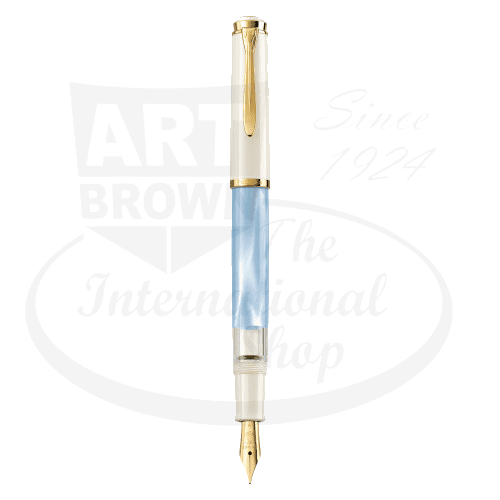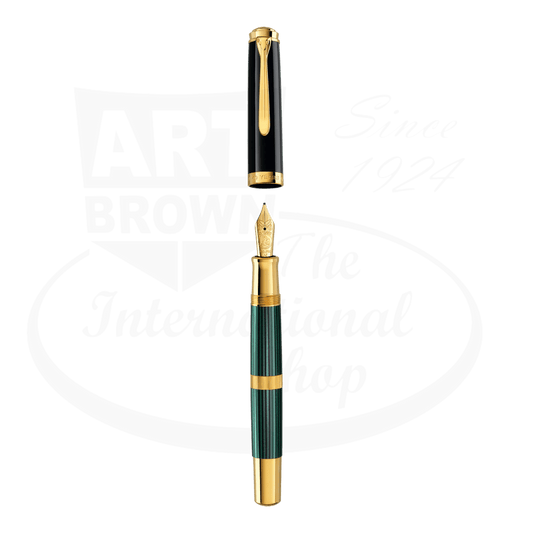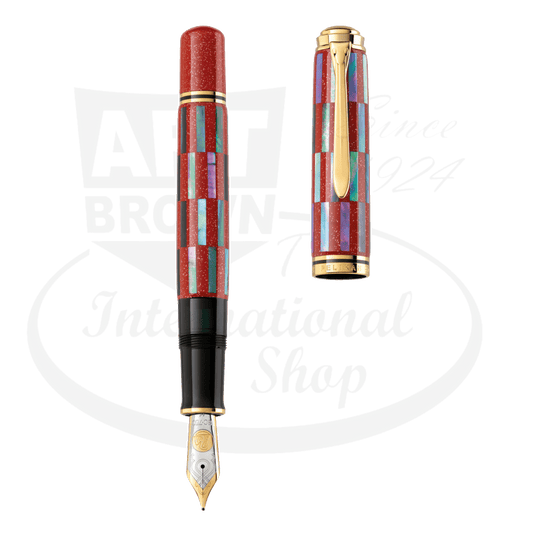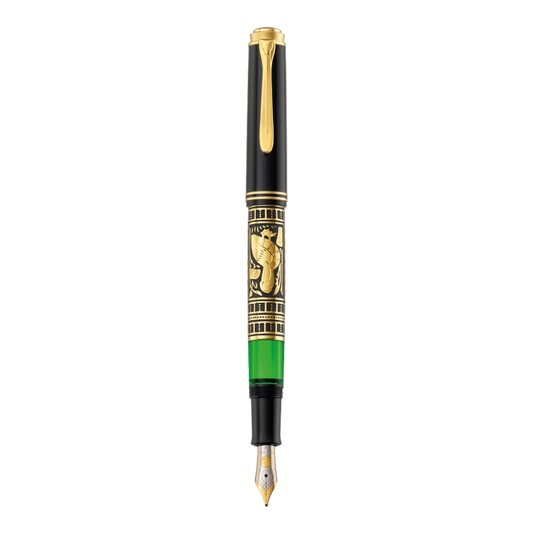The beginnings of the Pelikan Company trace back to the chemist Carl Hornemann, who made his customers an offer for oil paints, watercolors and for so called “farbige Dinten”—colored inks, on April 28, 1838. This price list—safely restored in the Pelikan archives—was the foundation of the company's manufacturing line, from which the worldwide known trademark Pelikan has developed.
Quality is the product of craftsmanship. It is the result of more than a century’s expertise. Even so, Pelikan relies on much more than just experience. The things that have been tried and tested over decades still need to inspire people both today and tomorrow. To meet the most sophisticated of demands at any time, they are consistently working to increase their accomplishments with the greatest passion. They show how you can refine ideas and develop visions. This is what Pelikan quality is all about, and how Pelikan has worked for more than 180 years – and this philosophy continues to guide them every day.
THE NIB
Decades of experience, specially trained employees, and the utmost care at every stage of the production process ensures that each nib is a masterpiece. About ten different steps are necessary to create a functioning nib out of a sheet of gold. Depending on the model, the nibs are crafted from 14 or 18-carat gold. In addition, they are sometimes rhodanized to create a silver sheen. The decoration on the nib is typical for every model. In the case of Limited Editions, it is adapted to each theme. The nib is the heart of the Pelikan fountain pen. It is cut from a 14 or 18-carat gold sheet and subsequently punched, formed and stamped into its classic quill-shaped appearance.
The nib is the heart of the Pelikan fountain pen. It is cut from a 14 or 18-carat gold sheet and subsequently punched, formed and stamped into its classic quill-shaped appearance.
The tip of the nib is made of iridium, a refined metal of the platinum group. It is welded to the front part of the gold nib and subsequently form-grinded, slotted and polished.
The quality is constantly checked. The nibs are subjected to numerous mechanical, manual, and optical tests at each stage of production.
The nibs rotate in a water tank for 24 hours, where they are polished by thousands of small porcelain particles. This process eliminates any rough seams which might remain. A final polish is then given to the nibs with minute copper balls.
After more than 30 high-precision operations, the gold nibs are eventually ready for use. Here is a traditional quality product bearing the unique features of its trademark.
 As a last step, every nib is tested by hand. All Pelikan fountain pens have a special insert inside the cap that ensures an airtight fit and thus the immediate flow of ink, even after a longer period of rest. The perfect ink flow depends largely on the ink feeder, which incorporates our decades of experience. It sits beneath the nib and works with capillary forces, therefore the exact distance between every lamella is of essential importance. Pelikan offers up to ten different nib sizes that can be exchanged easily and whenever necessary.
As a last step, every nib is tested by hand. All Pelikan fountain pens have a special insert inside the cap that ensures an airtight fit and thus the immediate flow of ink, even after a longer period of rest. The perfect ink flow depends largely on the ink feeder, which incorporates our decades of experience. It sits beneath the nib and works with capillary forces, therefore the exact distance between every lamella is of essential importance. Pelikan offers up to ten different nib sizes that can be exchanged easily and whenever necessary.
THE SLEEVE
In 1950, the model 400 was launched. With its green-striped sleeve, it has become a world-wide symbol for the brand of Pelikan. In the eighties, the series was baptized Souverän, though popular lore has taken to calling it by its nickname Stresemann because the state secretary of the “Weimarer Republik” was famed for his striped suits.
 These green/black Stresemann stripes are the result of numerous manufacturing steps. Firstly, a small plate of raw material is punched out of a sheet and then welded into a tube.
These green/black Stresemann stripes are the result of numerous manufacturing steps. Firstly, a small plate of raw material is punched out of a sheet and then welded into a tube.
Artificial resin is sprayed into the inside of the tube, sealing it to prevent the ink from leaking.
A high-precision lathe with grinding diamond then gives the Stresemann barrel its classic profile and leaves it smooth but graspable to the touch.
The cap rings cut from a brass tube are then gold-plated with high-quality material. And an injection molding machine fixes the rings to the cap.
THE ASSEMBLY
The invention of the piston filling system made it possible to fill a fountain pen in a clean and easy way.
The plastic in the ink regulator is heated and pressed onto the engraved and tested gold nib. The two now fit together perfectly.
The finished nib is tested by hand and adjusted to provide life-long satisfaction. This requires a great deal of experience and skill.
The assembly of the cap is the last step of the production. The famous Pelikan clip is slipped over the end of the cap and finally the Pelikan emblem is attached.
A masterpiece of traditional and high-quality manufacturing has been completed. A piece of precision work enabling life-long pleasure in writing: classic, appealing, and good.
THE SOUVERAN
 1950 was the year of birth of the model 400. Even today, this classic with a black-and-green pinstripe sleeve is still considered a symbol of the Pelikan brand worldwide. In the 1980s, the series was given the name "Souverän®", meaning sovereign in German. However, people often refer to it by its colloquial name "Stresemann" after the striped suits worn by the Germany Foreign Minister of the name in the 1920s.
1950 was the year of birth of the model 400. Even today, this classic with a black-and-green pinstripe sleeve is still considered a symbol of the Pelikan brand worldwide. In the 1980s, the series was given the name "Souverän®", meaning sovereign in German. However, people often refer to it by its colloquial name "Stresemann" after the striped suits worn by the Germany Foreign Minister of the name in the 1920s.
This name continues to write history today, and will do so in the future too. Today, this fountain pen exists in many variations and, despite the continual refinements of the design and technology, its fundamental mechanics remain the same. In these pens, you can witness the combination of expertise and craftsmanship in one fascinatingly smooth writing experience - prestige for highly varied demands and preferences.
THE TOLEDO
The art of Damascene patterns is thousands of years old. It comprises an elaborate method of applying ornamentation to steel or iron by impressing a thin gold film onto the surface. This sophisticated technology was brought to Spain by Arab settlers, where it was perfected over centuries, especially in the city of Toledo.
Exclusive design, selected materials, precise elaboration and highest writing comfort: The Souverän® fine writing instruments stands for permanent quality.
 Pelikan commenced honouring this Damascene patterning technique for its model "Toledo®" as early as 1931. This artwork is so highly coveted that it has continued to spread its magic for decades, almost unchanged. Today, the decorative barrel is produced from a single piece of 925 Sterling Silver. Once the barrel has received multiple, special treatments, the motif is applied using a layer of gold. In the next step, the motif is etched on by hand, with the filigree detail giving the motif a life of its own.
Pelikan commenced honouring this Damascene patterning technique for its model "Toledo®" as early as 1931. This artwork is so highly coveted that it has continued to spread its magic for decades, almost unchanged. Today, the decorative barrel is produced from a single piece of 925 Sterling Silver. Once the barrel has received multiple, special treatments, the motif is applied using a layer of gold. In the next step, the motif is etched on by hand, with the filigree detail giving the motif a life of its own.
Whoever owns a Toledo® writing instrument possesses a work of art and a small piece of history.
Shop our selection of Pelikan Fine Writing Instruments now: https://savingspros.com/collections/pelikan






